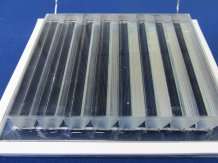Research shows how buildings can better generate and retain energy

A PhD student at the Environment and Sustainability Institute (ESI) on the University of Exeter's Penryn Campus has published research whose aim is to help improve the efficiency and performance of Building Integrated Photovoltaic (BiPV) systems.
BiPV systems are increasingly important; their photovoltaic – PV – power is generated close to where it's consumed, so it's well integrated into the building's architecture and, having no distance to travel, loses little power on the way. However, the technology can be expensive and less efficient than it might be, which is where Hasan Baig's research can make a contribution. He's experimenting with Building Integrated Concentrated Photovoltaic (BICPV) systems: these concentrate sunlight and could integrate well in the building architecture.
Specifically, Hasan and Dr. Nabin Sarmah have been experimenting with ways to improve the performance of these systems by adding a reflective film along the edges of the concentrator to capture the escaping rays and minimise optical losses. Use of the film appears to increase the system's average power output and reduce heat loss, potentially representing important energy savings and cost benefits. In addition, the experiments showed improvements in light conversion efficiency to increase the triple benefit (light, heat and electricity) within the building.
Hasan says "Buildings are one of the largest consumers of energy; designing energy generation systems which can integrate well with their architecture could have a very large impact on reducing our future energy needs".
His research supervisor, Professor Tapas Mallick, Chair in Clean Technologies (Renewable Energy) at the ESI adds "The South West has 20 per cent more solar energy available compared to the rest of UK; if such technology were applied to 50 per cent of south west England's existing buildings, it would meet the energy demands for two-thirds of those buildings".
More information: Hasan Baig, Nabin Sarmah, Daniel Chemisana, Joan Rosell, Tapas K. Mallick, "Enhancing performance of a linear dielectric based concentrating photovoltaic system using a reflective film along the edge," Energy, Volume 73, 14 August 2014, Pages 177-191, ISSN 0360-5442, dx.doi.org/10.1016/j.energy.2014.06.008.
Provided by University of Exeter


















